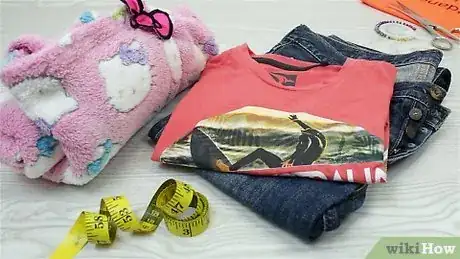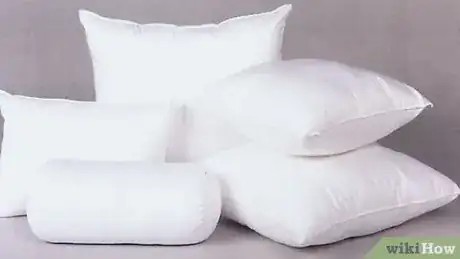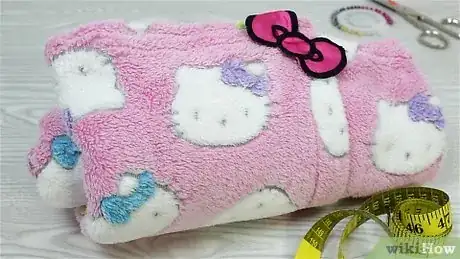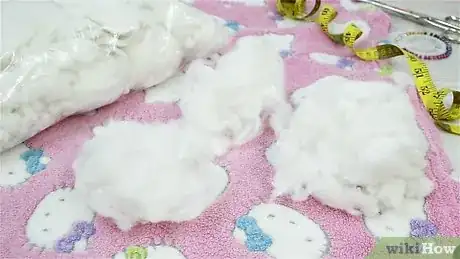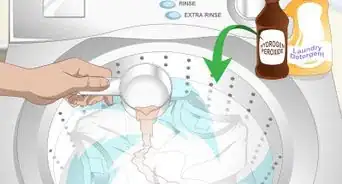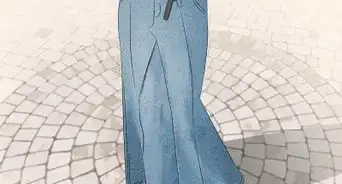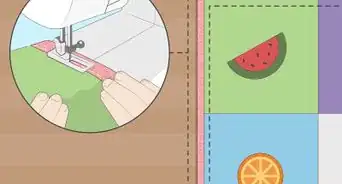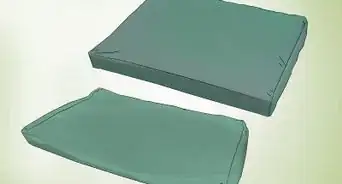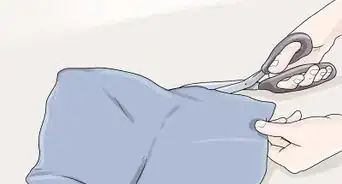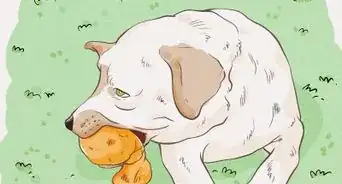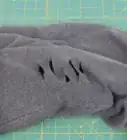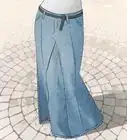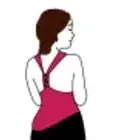This article was co-authored by Mia Danilowicz. Mia Danilowicz is a Master Tailor who works onset and on the red carpet in Los Angeles, California. With over a decade of experience, Mia specializes in bridal and gown couturier fittings, garment reconstruction, and custom design. Mia has worked at the Oscars, Grammys, SAG Awards, and Golden Globes. Her clients include a long list of entertainment and fashion industry headliners, major fashion magazines, luxury consumer brands, and popular media. Mia was trained at the Fashion Institute of Design and Merchandising and received her AA in Fashion Design and BS in Business Management.
There are 7 references cited in this article, which can be found at the bottom of the page.
This article has been viewed 102,797 times.
We all have old clothes that we don’t wear anymore. Rather than let them sit in the closet forever, how about repurposing them into some cute pillows? It’s a great way to recycle your clothes instead of throwing them out, and you can get creative with a variety of fabric options.
Steps
Selecting Materials
-
1Gather your old clothing. Dig through your closet and find articles of clothing that you no longer wear and that would make for a great color or design for a pillow. You want to select clothing that is relatively intact, as you will be repurposing the fabric.
- Clothing items that are well suited to this refashioning include denim jackets, flannel shirts, and long skirts or dresses that feature lots of fabric.
- Look for clothing items that have interesting designs or patterns on them, such as floral arrangements or plaid. These designs can help spice up your pillow design.
- Buckles, zippers and buttons that are on the clothing can be incorporated into the pillow as well. If you choose to highlight these items, cut your fabric appropriately.
- If you're missing that one color that will complete your design, consider visiting a thrift shop, or ask your neighbors if they have any clothing they no longer want.
-
2Choose the type of pillow you want to create. There are a variety of pillow designs out there, so think about the purpose of the pillow.
- Will the pillow be for decorative purposes? In this case, the size, shape and fabric are entirely up to your own liking. Decorative pillows are rarely sat upon, so comfort doesn't need to be a factor.
- Will the pillow be used as a cushion? For example, will people be lying against the pillow on the couch, or will the pillow be used as a sleeping pillow? If so, size, shape, fabric and stuffing will all play an important part in the comfort level of the pillow.
- Common throw pillow sizes are square in shape and range in size from 12"x12" to 24"x24".[1]
- Common bed pillows sizes are more rectangular in shape and start at 20"x26".[2]
Advertisement -
3Select the fabric you will be using for the pillow. Once you have identified the purpose of the pillow, select the fabric you wish to use from the old clothing you gathered earlier.
- Review your materials carefully. If you want to make a larger pillow but only have a small amount of the fabric needed, you may have to change your plan.
- Choose clothing with softer fabrics such as satin, silk, cotton or flannel if you are making a pillow that demands comfort, such as a bed pillow.
- Tougher fabrics, such as polyester or linen, are great to use as decorative pillows, as their sturdy composition helps the pillows maintain shape and last longer.
- Tougher fabrics are also useful if you need to make a sturdy cushion for kids or pets.[3]
-
4Select your pillow stuffing. Choosing the right stuffing for your pillow goes hand in hand with the fabric selection to create the perfect pillow for your needs. Different stuffing lends itself well to different purposes.
- Materials such as cotton, wool, and duck or goose down and feathers are among the softest types of pillow stuffing and are great for sleeping pillows. Take care when selecting; some stuffing, such as down, cannot be washed, as the feathers will not dry.
- Synthetic materials such as polyester, foam and microbeads tend to be cheaper than natural materials, and can range in their levels of firmness.
- Seeds and herbs like buckwheat, millet, flaxseed and lavender can also be used as pillow stuffing if you're making a decorative pillow. Note that this stuffing is harder than other types of stuffing and often a bit noisy. However, certain seeds and herbs give off a pleasant aroma, which can help enhance a decorative pillow’s purpose.[4]
Preparing Your Clothing
-
1Lay out the clothing you will be using for your pillow. Choose a hard surface, such as a work table or a hardwood floor. Turn the clothing inside out and smooth it free of wrinkles. You may want to iron the fabric before you begin working.
-
2Use a ruler or tape measure to measure out the size and shape needed for the pillow. Cut squares or rectangles into the fabric to make a simple pillow.[5] Make sure you add 1 inch to the intended size of your pillow to allow for proper leeway for seams. Trace along this measurement with chalk to give yourself a guide when cutting.
- If your article of clothing is identical on both its front and back side, and you are confident in your cutting ability, you can trace just one measurement with chalk and use it to cut both pieces of fabric at once.
- You may also mark both sides of the fabric with chalk if you like. This will be necessary if you are using two different articles of clothing for your pillow.
-
3Cut along the marked measurements using a sharp pair of scissors. If possible, cut the front and the back of the clothing at the same time to get two symmetrical pieces of fabric. If you plan on using two different styles of fabric for the pillow, you need only cut one piece from each garment of the appropriate measurement.
-
4Decorate the fabric. You can embroider the fabric, add ribbon, affix rhinestones or sequins, or even paint the surface of the fabric to make the design entirely yours.
- If you are painting or gluing decorations to the fabric, make sure that the paint or glue is appropriate for the fabric in question and will not damage the material. You may also want to choose washable paint or glue.
- Allow the paint or glue plenty of time to dry before continuing to work on your pillow.
-
5Pin the two pieces of fabric together. Lay the fabric pieces on top of one another so that when you sew the fabric pieces together, the pillowcase will be inside out. Place pins along the edges of the fabric to hold the shape of the pillow in place. [6]
- Make sure the pieces are perfectly aligned. If you're using fabric with a pattern, be sure the pattern won't look crooked once you sew the pillow.
- Leave one edge of the pillow unpinned, so you'll have room to stuff the pillow once it is sewn.
-
6Sew the fabric together. This can either be done by hand or by using a sewing machine. Sew the three pinned sides of the pillow case, making sure the seam is 1/4 to 1/2 inch away from the cut edge of the fabric.
- Consider using a slip stitch method to hide the threading on the pillow, if desired.
- The distance between the seam and the cut edge of the fabric will affect the tautness of the pillow and the amount of stuffing able to be placed inside. A larger seam allowance (1/2") means you will be able to place less stuffing inside of the pillow. The opposite is true for smaller seam allowances (1/4").
- Partially sew the fourth side of the pillow. Leave enough space on the fourth side so that you can easily fit your hand into the pillow case.
Finishing the Pillow
-
1Snip excess fabric from the corners of the fabric if desired. A gentle tapering of 1/2" on the corners of the fabric will help reduce sharp points on the pillow, giving it a rounder, softer look.
- Don't snip past the seam line!
-
2Remove the pins and turn the pillow cover right side out. The edges of the fabric will be hidden inside of the pillow, resulting in a smooth appearance.
-
3Stuff the pillow. Use the opening left in the case to insert the stuffing you have chosen for your pillow. Use more or less stuffing according to preference. To achieve even and leveled stuffing:
- Pull apart and fluff softer stuffing materials such as cotton or down. You are ensuring softness while removing hard clumps.
- Begin stuffing with small portions into the corner of the pillow farthest from the opening. Be gentle, but firm. You may use your hand or a spoon or rod to help stuff the pillow.
- Stuff the following corners in the same fashion. Slowly work your way toward the pillow opening.
- Keep an eye on the outside of the pillow as you stuff. Irregularities or divots visible on the outside of the pillow should be addressed with the redistribution or addition of stuffing.
- Once the pillow is mostly stuffed, give it a gentle squeeze. If the pillow is too firm, remove stuffing to your liking. If too soft, add more stuffing.[7]
- Hard stuffing such as microbeads or seed should not be packed too tightly in the pillow. Fill the pillow 3/4 of the way full with harder stuffing and then test the firmness.
- Hard stuffing can also be mixed with other, softer stuffing to help balance firmness. Seed and flower petals, for example, can make for an aromatic and texturally pleasing combination.
- Sew over the seams of your pillow to create a tighter seam if you are unsatisfied with the level of stuffing possible in your pillow. A tighter seam will create a tighter, compact environment for the stuffing.
-
4Close the pillow. Hand stitch the opening used for stuffing when you are satisfied with the pillow's appearance. If you are interested in retaining the ability to open the pillow, close the pillow by sewing a zipper into the opening. This will allow you to easily open the pillow to change the stuffing in the future.
- Make sure you're happy with way your pillow has been stuffed before closing the pillow.
- If you're using a piece of clothing with a zipper, you can align the zipper with the edge of the pillow so you can use it to open and close the pillow when desired.
Expert Q&A
Did you know you can get expert answers for this article?
Unlock expert answers by supporting wikiHow
-
QuestionHow do I make a pillow pattern?
 Mia DanilowiczMia Danilowicz is a Master Tailor who works onset and on the red carpet in Los Angeles, California. With over a decade of experience, Mia specializes in bridal and gown couturier fittings, garment reconstruction, and custom design. Mia has worked at the Oscars, Grammys, SAG Awards, and Golden Globes. Her clients include a long list of entertainment and fashion industry headliners, major fashion magazines, luxury consumer brands, and popular media. Mia was trained at the Fashion Institute of Design and Merchandising and received her AA in Fashion Design and BS in Business Management.
Mia DanilowiczMia Danilowicz is a Master Tailor who works onset and on the red carpet in Los Angeles, California. With over a decade of experience, Mia specializes in bridal and gown couturier fittings, garment reconstruction, and custom design. Mia has worked at the Oscars, Grammys, SAG Awards, and Golden Globes. Her clients include a long list of entertainment and fashion industry headliners, major fashion magazines, luxury consumer brands, and popular media. Mia was trained at the Fashion Institute of Design and Merchandising and received her AA in Fashion Design and BS in Business Management.
Master Tailor
-
QuestionHow do you make a pillow out of old shirts?
 Mia DanilowiczMia Danilowicz is a Master Tailor who works onset and on the red carpet in Los Angeles, California. With over a decade of experience, Mia specializes in bridal and gown couturier fittings, garment reconstruction, and custom design. Mia has worked at the Oscars, Grammys, SAG Awards, and Golden Globes. Her clients include a long list of entertainment and fashion industry headliners, major fashion magazines, luxury consumer brands, and popular media. Mia was trained at the Fashion Institute of Design and Merchandising and received her AA in Fashion Design and BS in Business Management.
Mia DanilowiczMia Danilowicz is a Master Tailor who works onset and on the red carpet in Los Angeles, California. With over a decade of experience, Mia specializes in bridal and gown couturier fittings, garment reconstruction, and custom design. Mia has worked at the Oscars, Grammys, SAG Awards, and Golden Globes. Her clients include a long list of entertainment and fashion industry headliners, major fashion magazines, luxury consumer brands, and popular media. Mia was trained at the Fashion Institute of Design and Merchandising and received her AA in Fashion Design and BS in Business Management.
Master Tailor
Things You'll Need
- Old clothes
- Scissors
- Needle
- Matching thread
- Common pins
- Sewing machine
- Stuffing
- Decorations
References
- ↑ http://www.pillowdecor.com/Square-Throw-Pillows-s/25.htm
- ↑ https://www.pacificcoast.com/blog/pillows/pillow-sizes-guide.html
- ↑ http://www.doityourself.com/stry/what-are-the-best-materials-for-pillow-cases#b
- ↑ http://www.sew4home.com/tips-resources/buying-guide/understanding-filler-materials-polyfil-pellets-microbeads-beanbag-filler
- ↑ Mia Danilowicz. Master Tailor. Expert Interview. 8 January 2021.
- ↑ http://www.rufflesandstuff.com/2011/07/turning-t-shirt-into-pillow-tutorial.html
- ↑ http://www.sew4home.com/tips-resources/sewing-tips-tricks/pillow-personality-fairfield-processing-pillow-stuffing-tips
